🚀 MonkeyOCR: Document Parsing with a Structure-Recognition-Relation Triplet Paradigm
MonkeyOCR simplifies document processing by adopting an SRR triplet paradigm, offering high performance and efficiency in parsing various types of documents.
🚀 Quick Start
1. Install MonkeyOCR
conda create -n MonkeyOCR python=3.10
conda activate MonkeyOCR
git clone https://github.com/Yuliang-Liu/MonkeyOCR.git
cd MonkeyOCR
pip install torch==2.5.1 torchvision==0.20.1 torchaudio==2.5.1 --index-url https://download.pytorch.org/whl/cu124
pip install -e .
2. Download Model Weights
Download our model from Huggingface.
pip install huggingface_hub
python tools/download_model.py
You can also download our model from ModelScope.
pip install modelscope
python tools/download_model.py -t modelscope
3. Inference
python parse.py path/to/your.pdf
python parse.py path/to/your/image
python parse.py path/to/your.pdf -o ./output -c config.yaml
Output Results
MonkeyOCR generates three types of output files:
- Processed Markdown File (
your.md): The final parsed document content in markdown format, containing text, formulas, tables, and other structured elements.
- Layout Results (
your_layout.pdf): The layout results drawn on the original PDF.
- Intermediate Block Results (
your_middle.json): A JSON file containing detailed information about all detected blocks, including:
- Block coordinates and positions
- Block content and type information
- Relationship information between blocks
These files provide both the final formatted output and detailed intermediate results for further analysis or processing.
4. Gradio Demo
pip install gradio==5.23.3
pip install pdf2image==1.17.0
python demo/demo_gradio.py
Fix shared memory error on RTX 3090 / 4090 / ... GPUs (Optional)
Our 3B model runs efficiently on NVIDIA RTX 3090. However, when using LMDeploy as the inference backend, you may encounter compatibility issues on RTX 3090 / 4090 GPUs — particularly the following error:
triton.runtime.errors.OutOfResources: out of resource: shared memory
To work around this issue, you can apply the patch below:
python tools/lmdeploy_patcher.py patch
⚠️ Important Note
This command will modify LMDeploy's source code in your environment. To revert the changes, simply run:
python tools/lmdeploy_patcher.py restore
Special thanks to @pineking for the solution!
Switch inference backend (Optional)
You can switch inference backend to transformers following the steps below:
- Install required dependency (if not already installed):
pip install flash-attn==2.7.4.post1 --no-build-isolation
- Open the
model_configs.yaml file.
- Set
chat_config.backend to transformers.
- Adjust the
batch_size according to your GPU's memory capacity to ensure stable performance.
Example configuration:
chat_config:
backend: transformers
batch_size: 10
✨ Features
MonkeyOCR adopts a Structure-Recognition-Relation (SRR) triplet paradigm, which simplifies the multi-tool pipeline of modular approaches while avoiding the inefficiency of using large multimodal models for full-page document processing.
- Compared with the pipeline-based method MinerU, our approach achieves an average improvement of 5.1% across nine types of Chinese and English documents, including a 15.0% gain on formulas and an 8.6% gain on tables.
- Compared to end-to-end models, our 3B-parameter model achieves the best average performance on English documents, outperforming models such as Gemini 2.5 Pro and Qwen2.5 VL-72B.
- For multi-page document parsing, our method reaches a processing speed of 0.84 pages per second, surpassing MinerU (0.65) and Qwen2.5 VL-7B (0.12).
MonkeyOCR currently does not support photographed documents, but we will continue to improve it in future updates. Stay tuned! Currently, our model is deployed on a single GPU, so if too many users upload files at the same time, issues like “This application is currently busy” may occur. We're actively working on supporting Ollama and other deployment solutions to ensure a smoother experience for more users. Additionally, please note that the processing time shown on the demo page does not reflect computation time alone—it also includes result uploading and other overhead. During periods of high traffic, this time may be longer. The inference speeds of MonkeyOCR, MinerU, and Qwen2.5 VL-7B were measured on an H800 GPU.
🚀🚀🚀 Chinese Video Tutorial (Thanks to leo009 for sharing!)
📚 Documentation
Benchmark Results
Here are the evaluation results of our model on OmniDocBench. MonkeyOCR-3B uses DocLayoutYOLO as the structure detection model, while MonkeyOCR-3B* uses our trained structure detection model with improved Chinese performance.
1. The end-to-end evaluation results of different tasks.
| Model Type |
Methods |
Overall Edit↓ (EN) |
Overall Edit↓ (ZH) |
Text Edit↓ (EN) |
Text Edit↓ (ZH) |
Formula Edit↓ (EN) |
Formula Edit↓ (ZH) |
Formula CDM↑ (EN) |
Formula CDM↑ (ZH) |
Table TEDS↑ (EN) |
Table TEDS↑ (ZH) |
Table Edit↓ (EN) |
Table Edit↓ (ZH) |
Read Order Edit↓ (EN) |
Read Order Edit↓ (ZH) |
| Pipeline Tools |
MinerU |
0.150 |
0.357 |
0.061 |
0.215 |
0.278 |
0.577 |
57.3 |
42.9 |
78.6 |
62.1 |
0.180 |
0.344 |
0.079 |
0.292 |
| Pipeline Tools |
Marker |
0.336 |
0.556 |
0.080 |
0.315 |
0.530 |
0.883 |
17.6 |
11.7 |
67.6 |
49.2 |
0.619 |
0.685 |
0.114 |
0.340 |
| Pipeline Tools |
Mathpix |
0.191 |
0.365 |
0.105 |
0.384 |
0.306 |
0.454 |
62.7 |
62.1 |
77.0 |
67.1 |
0.243 |
0.320 |
0.108 |
0.304 |
| Pipeline Tools |
Docling |
0.589 |
0.909 |
0.416 |
0.987 |
0.999 |
1 |
- |
- |
61.3 |
25.0 |
0.627 |
0.810 |
0.313 |
0.837 |
| Pipeline Tools |
Pix2Text |
0.320 |
0.528 |
0.138 |
0.356 |
0.276 |
0.611 |
78.4 |
39.6 |
73.6 |
66.2 |
0.584 |
0.645 |
0.281 |
0.499 |
| Pipeline Tools |
Unstructured |
0.586 |
0.716 |
0.198 |
0.481 |
0.999 |
1 |
- |
- |
0 |
0.06 |
1 |
0.998 |
0.145 |
0.387 |
| Pipeline Tools |
OpenParse |
0.646 |
0.814 |
0.681 |
0.974 |
0.996 |
1 |
0.11 |
0 |
64.8 |
27.5 |
0.284 |
0.639 |
0.595 |
0.641 |
| Expert VLMs |
GOT-OCR |
0.287 |
0.411 |
0.189 |
0.315 |
0.360 |
0.528 |
74.3 |
45.3 |
53.2 |
47.2 |
0.459 |
0.520 |
0.141 |
0.280 |
| Expert VLMs |
Nougat |
0.452 |
0.973 |
0.365 |
0.998 |
0.488 |
0.941 |
15.1 |
16.8 |
39.9 |
0 |
0.572 |
1.000 |
0.382 |
0.954 |
| Expert VLMs |
Mistral OCR |
0.268 |
0.439 |
0.072 |
0.325 |
0.318 |
0.495 |
64.6 |
45.9 |
75.8 |
63.6 |
0.600 |
0.650 |
0.083 |
0.284 |
| Expert VLMs |
OLMOCR-sglang |
0.326 |
0.469 |
0.097 |
0.293 |
0.455 |
0.655 |
74.3 |
43.2 |
68.1 |
61.3 |
0.608 |
0.652 |
0.145 |
0.277 |
| Expert VLMs |
SmolDocling-256M |
0.493 |
0.816 |
0.262 |
0.838 |
0.753 |
0.997 |
32.1 |
0.55 |
44.9 |
16.5 |
0.729 |
0.907 |
0.227 |
0.522 |
| General VLMs |
GPT4o |
0.233 |
0.399 |
0.144 |
0.409 |
0.425 |
0.606 |
72.8 |
42.8 |
72.0 |
62.9 |
0.234 |
0.329 |
0.128 |
0.251 |
| General VLMs |
Qwen2.5-VL-7B |
0.312 |
0.406 |
0.157 |
0.228 |
0.351 |
0.574 |
79.0 |
50.2 |
76.4 |
72.2 |
0.588 |
0.619 |
0.149 |
0.203 |
| General VLMs |
InternVL3-8B |
0.314 |
0.383 |
0.134 |
0.218 |
0.417 |
0.563 |
78.3 |
49.3 |
66.1 |
73.1 |
0.586 |
0.564 |
0.118 |
0.186 |
| Mix |
MonkeyOCR-3B [Weight] |
0.140 |
0.297 |
0.058 |
0.185 |
0.238 |
0.506 |
78.7 |
51.4 |
80.2 |
77.7 |
0.170 |
0.253 |
0.093 |
0.244 |
| Mix |
MonkeyOCR-3B* [Weight] |
0.154 |
0.277 |
0.073 |
0.134 |
0.255 |
0.529 |
78.5 |
50.8 |
78.2 |
76.2 |
0.182 |
0.262 |
0.105 |
0.183 |
2. The end-to-end text recognition performance across 9 PDF page types.
| Model Type |
Models |
Book |
Slides |
Financial Report |
Textbook |
Exam Paper |
Magazine |
Academic Papers |
Notes |
Newspaper |
Overall |
| Pipeline Tools |
MinerU |
0.055 |
0.124 |
0.033 |
0.102 |
0.159 |
0.072 |
0.025 |
0.984 |
0.171 |
0.206 |
| Pipeline Tools |
Marker |
0.074 |
0.340 |
0.089 |
0.319 |
0.452 |
0.153 |
0.059 |
0.651 |
0.192 |
0.274 |
| Pipeline Tools |
Mathpix |
0.131 |
0.220 |
0.202 |
0.216 |
0.278 |
0.147 |
0.091 |
0.634 |
0.690 |
0.300 |
| Expert VLMs |
GOT-OCR |
0.111 |
0.222 |
0.067 |
0.132 |
0.204 |
0.198 |
0.179 |
0.388 |
0.771 |
0.267 |
| Expert VLMs |
Nougat |
0.734 |
0.958 |
1.000 |
0.820 |
0.930 |
0.830 |
0.214 |
0.991 |
0.871 |
0.806 |
| General VLMs |
GPT4o |
0.157 |
0.163 |
0.348 |
0.187 |
0.281 |
0.173 |
0.146 |
0.607 |
0.751 |
0.316 |
| General VLMs |
Qwen2.5-VL-7B |
0.148 |
0.053 |
0.111 |
0.137 |
0.189 |
0.117 |
0.134 |
0.204 |
0.706 |
0.205 |
| General VLMs |
InternVL3-8B |
0.163 |
0.056 |
0.107 |
0.109 |
0.129 |
0.100 |
0.159 |
0.150 |
0.681 |
0.188 |
| Mix |
MonkeyOCR-3B [Weight] |
0.046 |
0.120 |
0.024 |
0.100 |
0.129 |
0.086 |
0.024 |
0.643 |
0.131 |
0.155 |
| Mix |
MonkeyOCR-3B* [Weight] |
0.054 |
0.203 |
0.038 |
0.112 |
0.138 |
0.111 |
0.032 |
0.194 |
0.136 |
0.120 |
3. Comparing MonkeyOCR with closed-source and extra large open-source VLMs.
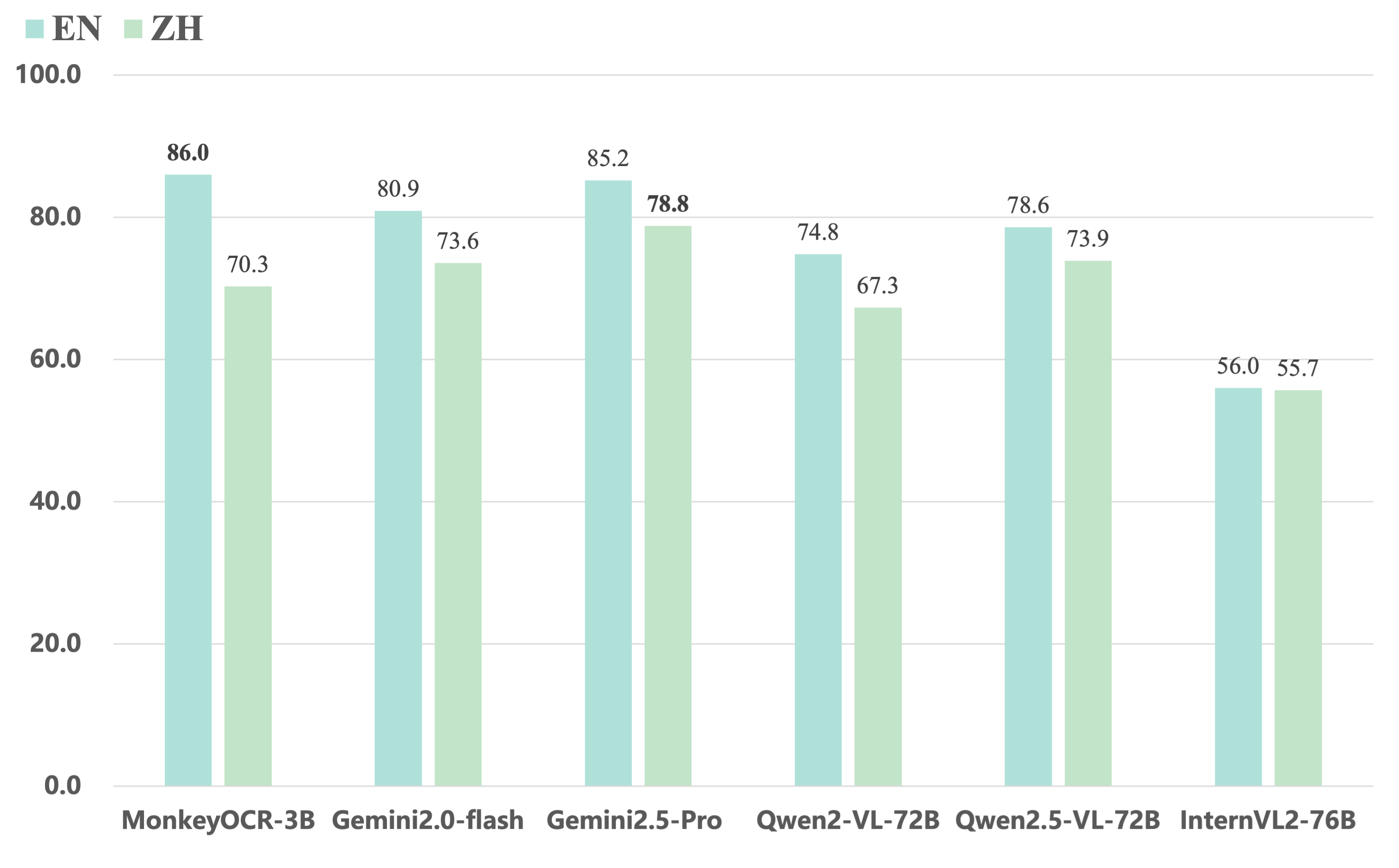
Visualization Demo
Get a Quick Hands-On Experience with Our Demo: http://vlrlabmonkey.xyz:7685
Our demo is simple and easy to use:
- Upload a PDF or image.
- Click “Parse (解析)” to let the model perform structure detection, content recognition, and relationship prediction on the input document. The final output will be a markdown-formatted version of the document.
- Select a prompt and click “Test by prompt” to let the model perform content recognition on the image based on the selected prompt.
Example for formula document
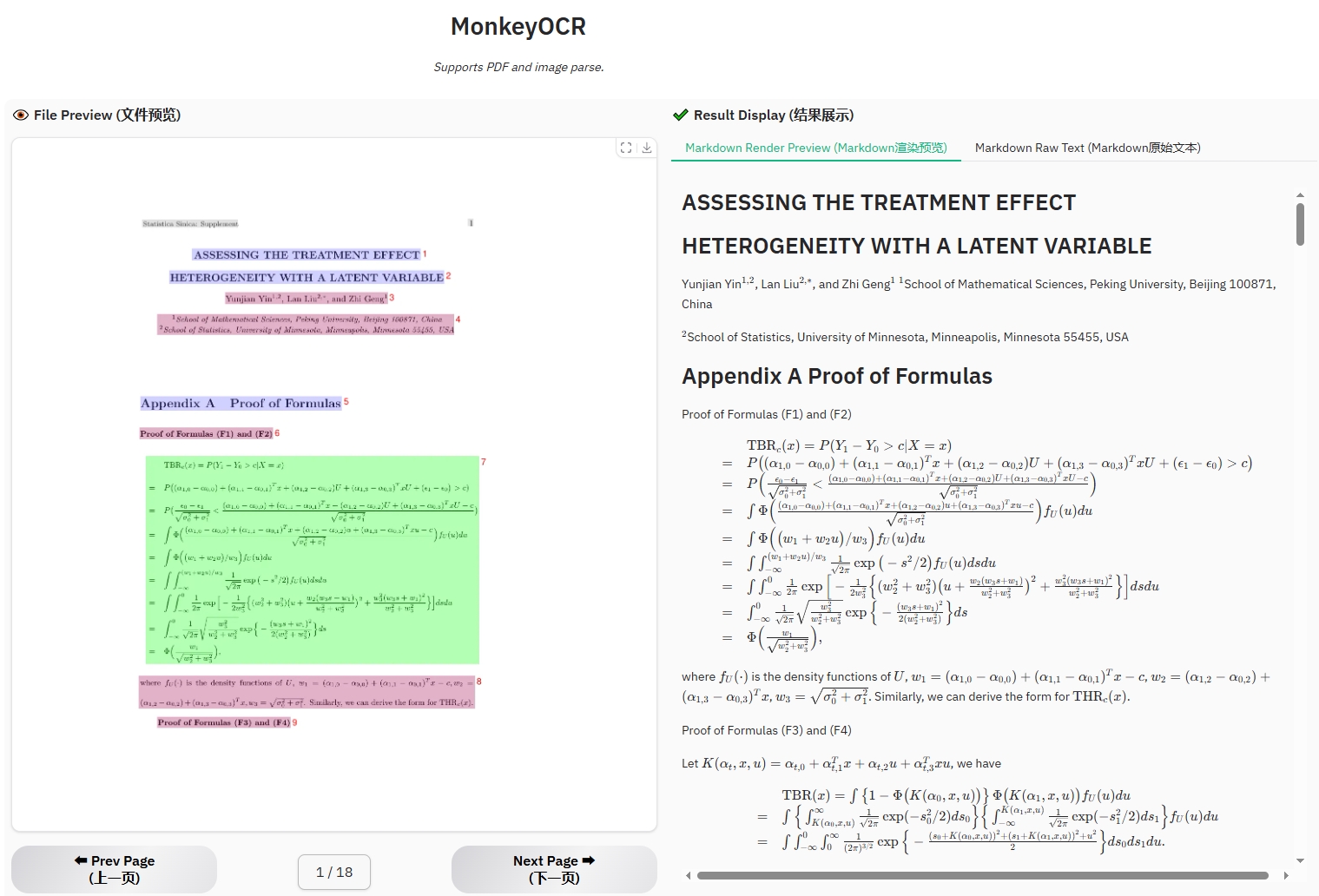
Example for table document
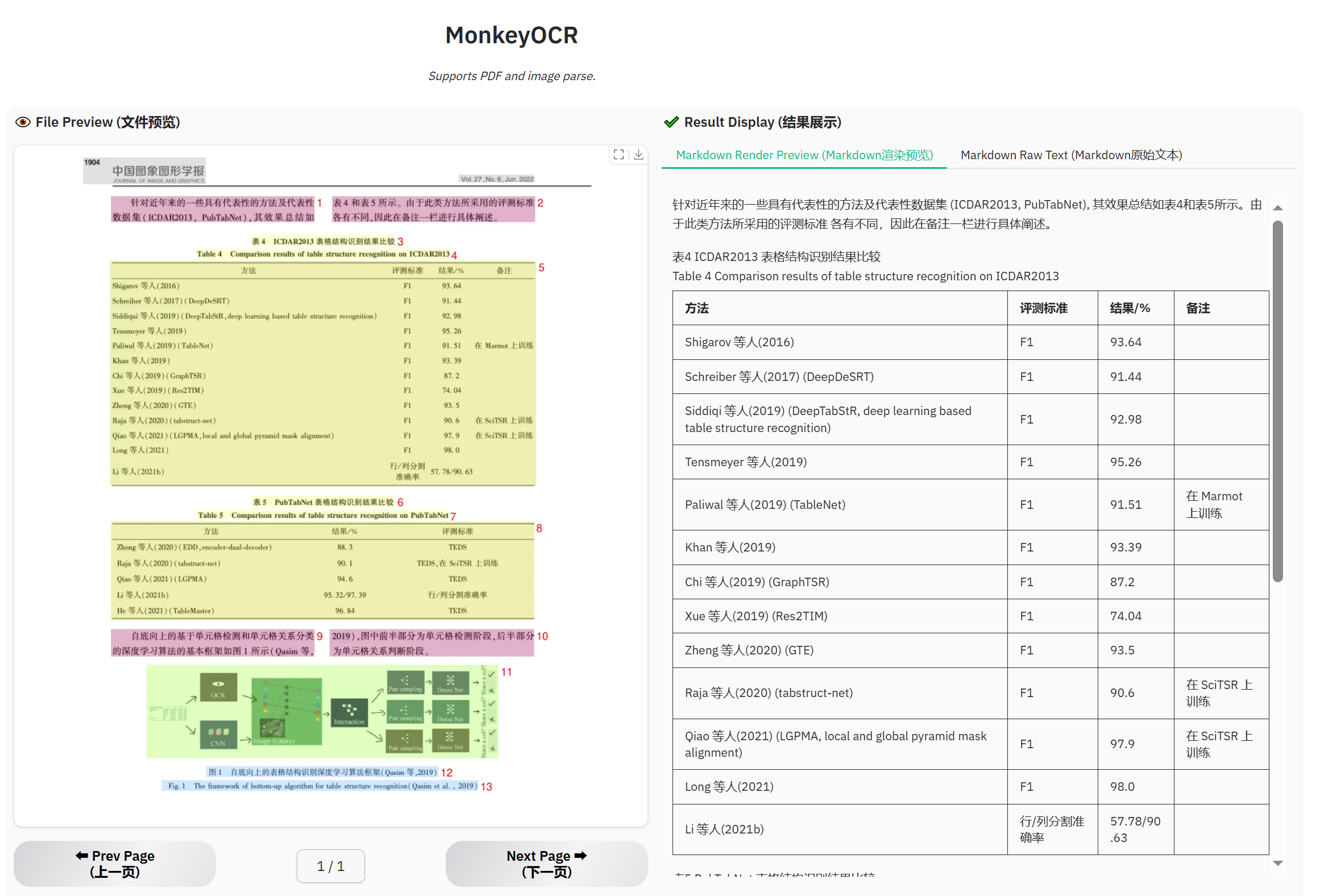
Example for newspaper
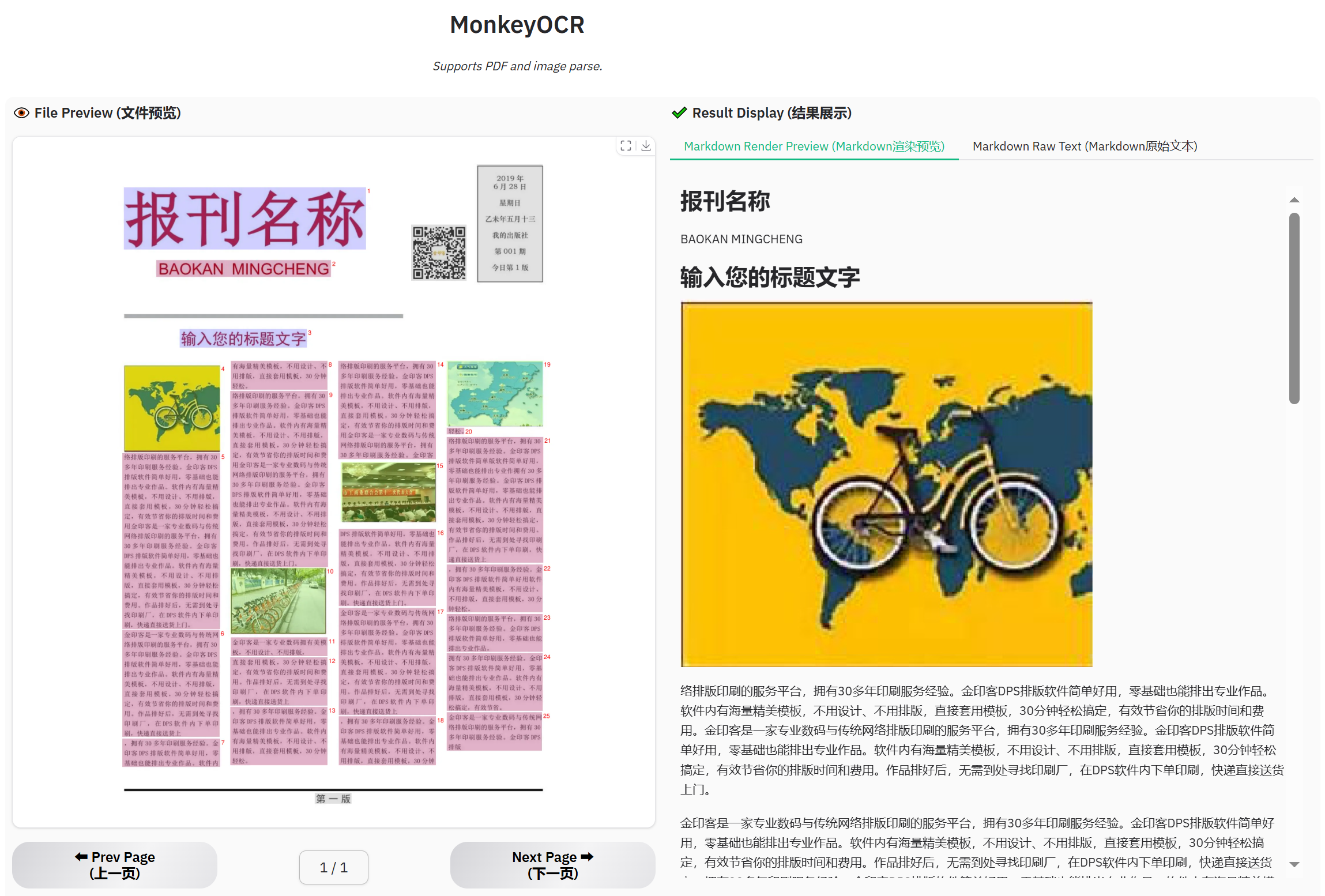
Example for financial report
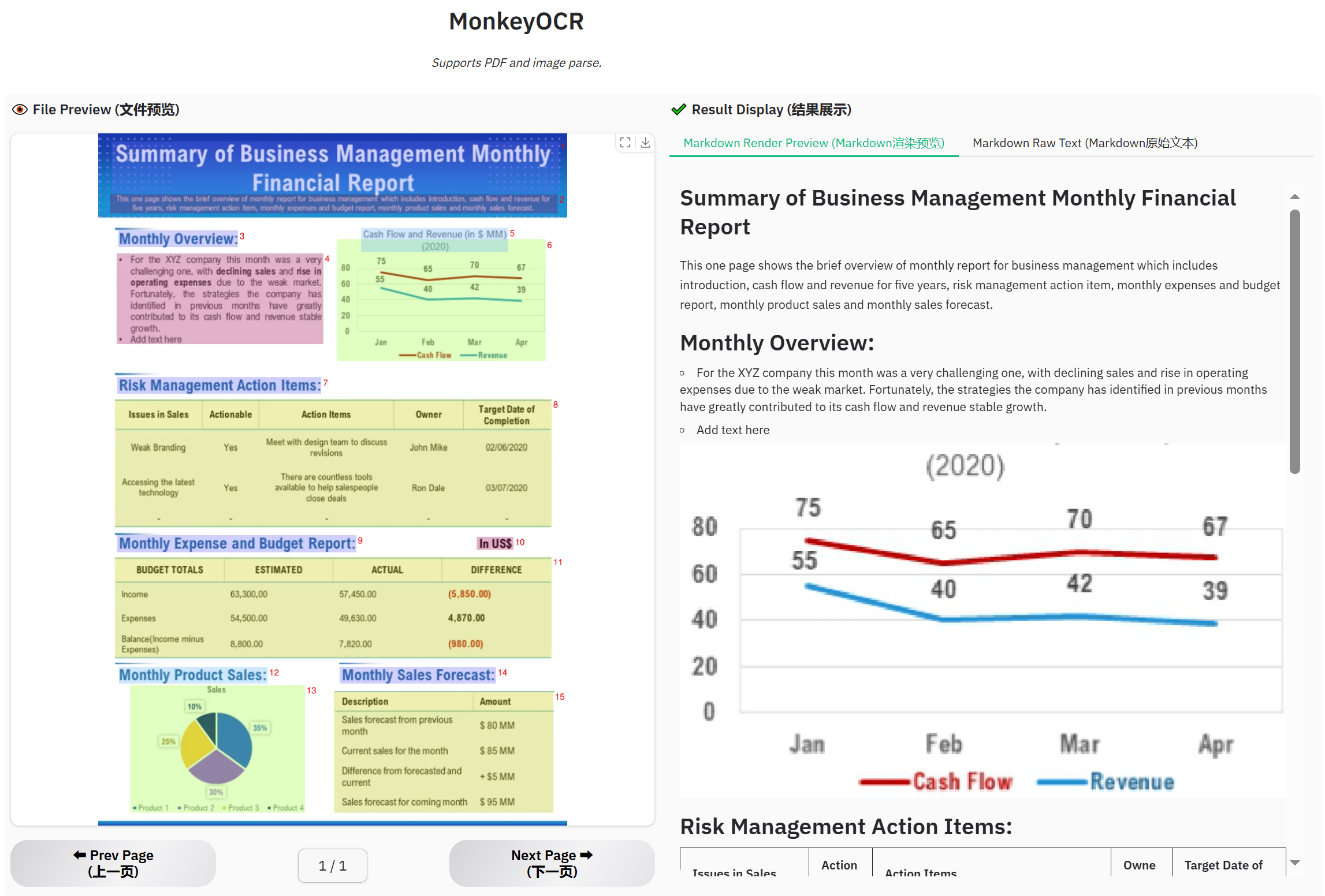
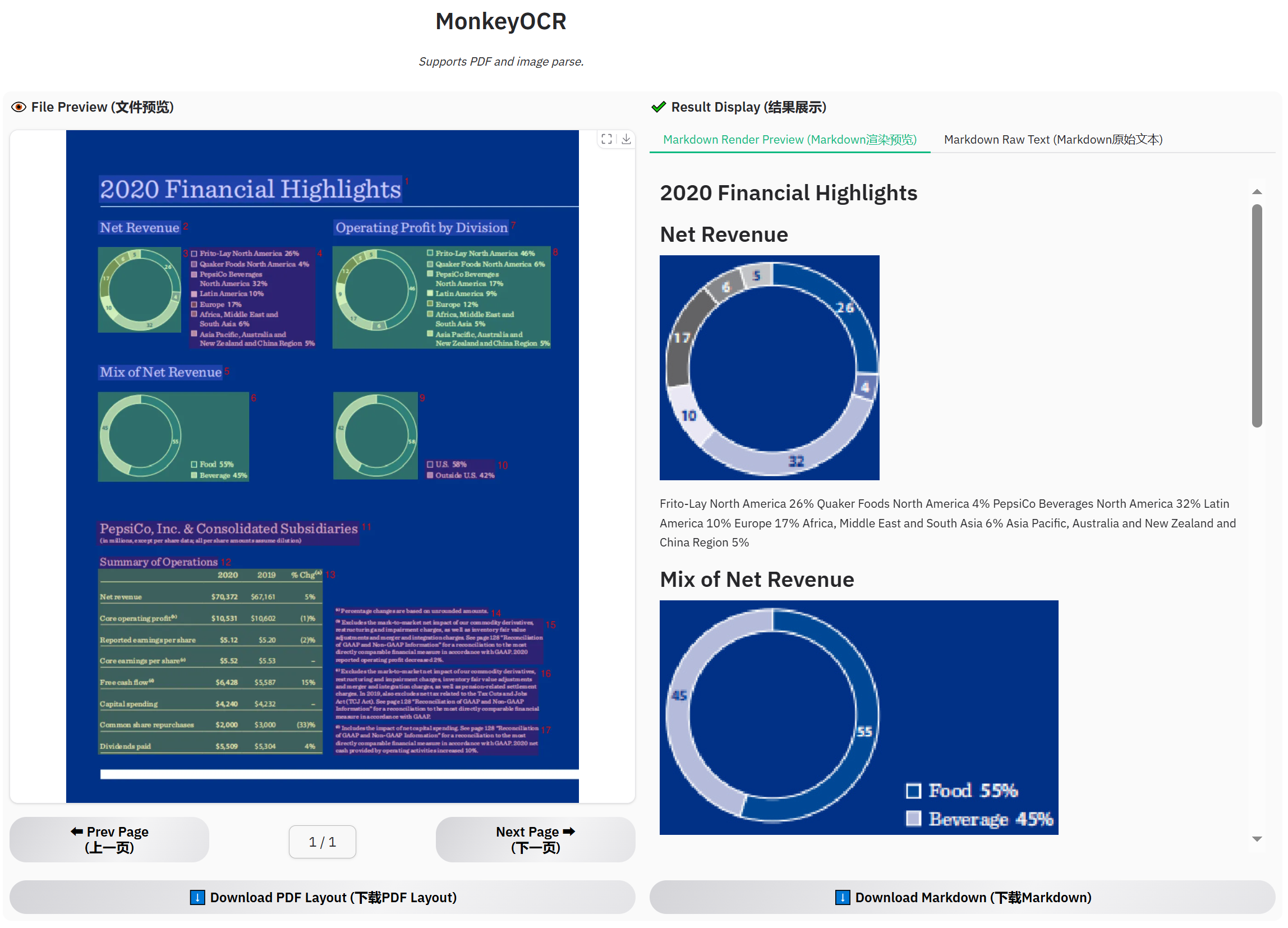
📄 License
The project is open-sourced under relevant open-source licenses.
📚 Citing MonkeyOCR
If you wish to refer to the baseline results published here, please use the following BibTeX entries:
@misc{li2025monkeyocrdocumentparsingstructurerecognitionrelation,
title={MonkeyOCR: Document Parsing with a Structure-Recognition-Relation Triplet Paradigm},
author={Zhang Li and Yuliang Liu and Qiang Liu and Zhiyin Ma and Ziyang Zhang and Shuo Zhang and Zidun Guo and Jiarui Zhang and Xinyu Wang and Xiang Bai},
year={2025},
eprint={2506.05218},
archivePrefix={arXiv},
primaryClass={cs.CV},
url={https://arxiv.org/abs/2506.05218},
}
👏 Acknowledgments
We would like to thank MinerU for providing relevant references and inspiration.






 Transformers
Transformers